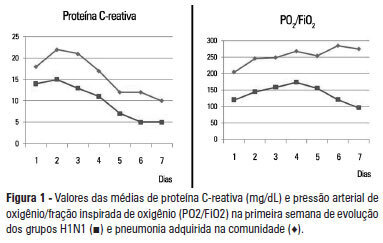
OBJECTIVE: To analyze the clinical, laboratory and evolution data of patients with severe influenza A H1N1 pneumonia and compare the data with that of patients with severe community-acquired bacterial pneumonia. METHODS: Cohort and retrospective study. All patients admitted to the intensive care unit between May 2009 and December 2010 with a diagnosis of severe pneumonia caused by the influenza A H1N1 virus were included in the study. Thirty patients with severe community-acquired pneumonia admitted within the same period were used as a control group. Severe community-acquired pneumonia was defined as the presence of at least one major severity criteria (ventilator or vasopressor use) or two minor criteria. RESULTS: The data of 45 patients were evaluated. Of these patients, 15 were infected with H1N1. When compared to the group with community-acquired pneumonia, patients from the H1N1 group had significantly lower leukocyte counts on admission (6,728±4,070 versus 16,038±7,863; p<0.05) and lower C-reactive protein levels (Day 2: 15.1±8.1 versus 22.1±10.9 mg/dL; p<0.05). The PaO2/FiO2 ratio values were lower in the first week in patients with H1N1. Patients who did not survive the H1N1 severe pneumonia had significantly higher levels of C-reactive protein and higher serum creatinine levels compared with patients who survived. The mortality rate was significantly higher in the H1N1 group than in the control group (53% versus 20%; p=0.056, respectivelly). CONCLUSION: Differences in the leukocyte count, C-reactive protein concentrations and oxygenation profiles may contribute to the diagnosis and prognosis of patients with severe influenza A H1N1 virus-related pneumonia and community-acquired pneumonia.
Search
Search in:


Comments